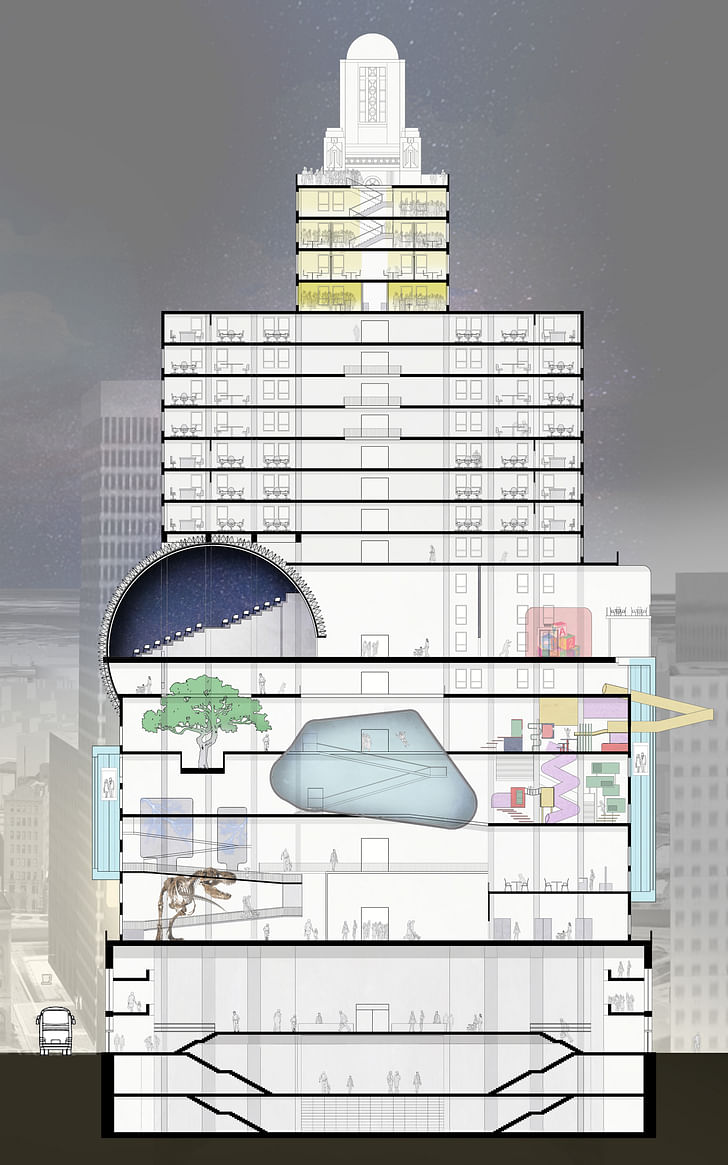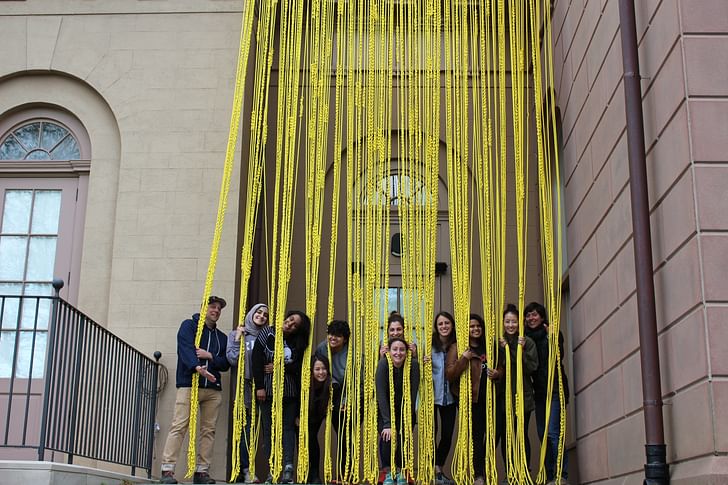

Unique to RISD's Interior Architecture Department (INTAR) is its one-year post-professional Master of Arts in Adaptive Reuse program. In this feature we take a closer look at the mission and goals for the students of Archinect’s newest School Partner. According to Interior Architecture Department Head Liliane Wong, "The program emphasizes the importance of understanding and respecting the context of the existing structure and making design interventions that contribute to the layers of history embedded in our built environment."
To learn more Archinect spoke with Wong, Graduate Program Director Stefano Corbo, and several current students and alumni from the MA Adaptive Reuse program to learn about their experiences and program takeaways. Together we explore the program's mission and how students are prepared to develop expertise in adaptive reuse, historic preservation, and architectural interiors.

What does RISD’s Interior Architecture MA in Adaptive Reuse do differently and how does it push its students?
Wong and Corbo: Contrary to any conventional post-professional degree in Architecture, The MA in Adaptive Reuse suggests a very clear direction for the future of our discipline – students are invited to transform, reuse, adapt, recycle, and not to build from scratch. In opposition of destroying the past to give space to the new, we at INTAR believe in the historic, economic, and cultural relevance of reuse.
The Master of Arts [MA] in Adaptive Reuse is a unique specialist design education on the subject of adaptive reuse as a post-professional study to a first degree in Architecture. It is an immersive year focused on a subject that is not part of a NAAB-accredited architectural program. Architects emerge from this program with a unique expertise that sets them apart.
The students are introduced to adaptive reuse through both practice and theory. The spring semester culminates in a nine-credit design project, anchored in the community, that allows the students to put into practice the principles of adaptive reuse. The program emphasizes the importance of understanding and respecting the context of the existing structure and of making design interventions that contribute to the layers of history embedded in our built environment. Reuse is not merely a conservatory act. Reuse is design. Reuse is to prolong building’s life cycle, by providing new functions and new meaning. Reuse is sustainable.
In opposition of destroying the past to give space to the new, we at INTAR believe in the historic, economic and cultural relevance of reuse [...] Reuse is not merely a conservatory act. Reuse is design. Reuse is to prolong building’s life cycle, by providing new functions and new meaning. Reuse is sustainable. - Stefano Corbo, Graduate Program Director
What qualities do the students who flourish in the program possess?
The students of this program are architects who are interested in reuse rather than the erection of new forms. Following upon the statement of 2018 AIA President Carl Elefante that the “Greenest building is the one that is already built,” the curriculum of the MA in Adaptive Reuse is inherently one of sustainability.
In order to comprehend the complexity and the value of existing structures, students with strong traditional architectural backgrounds – from representation to an understanding of systems – will integrate their expertise with dedicated courses on Theory of Adaptive Reuse, Principles and Methods of Intervention, Building systems.
How does the program’s curriculum help to enrich and support these students?
The 45-credit curriculum provides a specific focus on the practice of adaptive reuse through both design studio and support courses.The Summer Studio in Copenhagen, a city dedicated to a green and sustainable society, sets the tone for the program. The first of three studios, the Summer Studio project is one that repurposes a site within the city. The second studio of the curriculum is one selected by the student from the Department’s Advanced Standing Studios. The final Adaptive Reuse studio is both a design studio and a full-scale demonstration of such practice in a real-life context. Studios are complemented by support courses in sustainable systems and theory. As the program is intended for a small, selective cohort, the courses and studios are conducted in uniquely small student-professor ratios. The MA Program also includes a field trip to Scandinavia – Denmark, Sweden, Norway – where students can visit, study and analyze canonical examples of Adaptive Reuse.
The curriculum enables the student to develop strategies that recognize the importance of social and environmental responsibility while expanding upon the architect’s understanding of reuse as a product of practice and theory.
Wong and students in the MA class have worked on a variety of projects that focus on historic preservation and the impact of sea level rise on a historic neighborhood in Newport, Rhode Island. According to Wong her biggest takeaway from these projects has been the feedback and media coverage of the student work. Specifically she talks about Saving Superman and the response it received form the community, "This interest came from all sectors of the community from historic preservationists to entrepreneurs and city planners. Since graduation, the students, now alums, have been invited to present their work at different venues including the Venture Café, GrowSmart RI, the Providence Preservation Society and the Dept. of Commerce," Wong explains.
Below students Ankit Mandewewala (MA '20), Michele Katora (MA '20), Rohit Vantaram Rao (MA '17), Eder Romero (MA '17), and Jorge Gomez (MA '15) share with Archinect their biggest takeaways from the program, the work they produced and how it shaped them as they entered professional practice.
What were your biggest takeaways from the program?
Jorge Gomez: It changed the way I thought about architecture. Before the program, I wanted to design from scratch, with a clear canvas that resulted in a new product. I did not see the value, beauty or potential in something old, abandoned or in disrepair. Having a structure that can be salvaged and reinvented for another use inherently becomes unique. It combines old technology with new by using various methods and techniques not readily available or common knowledge in architecture. It is a design approach specifically taught in this program to take into account both the present, and the reintroduction of the past.
It changed the way I thought about architecture. Before the program, I wanted to design from scratch, with a clear canvas that resulted in a new product. I did not see the value, beauty or potential in something old, abandoned or in disrepair - Jorge Gomez '15
Rohit Vantaram Rao: The program and the projects we worked on therein, pushed my design capabilities to corners I didn’t know existed. I remember simply hitting mental walls in a fall semester project but through the patience of the instructor, inspiring classmates and the wonderful Fleet library, I emerged out the end of that tunnel feeling quite triumphant and truly proud of the work I’d managed to produce. The process instilled a great clarity of what adaptive reuse meant and set in this excitable fire that still jumps to life whenever I start work on a new project. I live for that excitement and I am truly thankful to the program for helping me find it. Additionally, the use of AR and VR in our year-end project really opened up a world of possibilities in design presentation and the ability to really get your ideas across to a client/user in the most easy-to-understand manner!
Eder Romero: One of my biggest takeaways from the program is the knowledge to identify potential opportunities in every existing condition and historic preservation project. The courses offered and the outstanding professors guided me to learn several ways to approach adaptive reuse projects and implement cutting edge technology, such as Augmented Reality and Virtual Reality.
How did Saving Superman reshape your perspectives on adaptive reuse and interior studies?
Ankit Mandewewala: Adaptive reuse isn’t just about reusing existing skeleton or structure. Buildings need to be inherently connected to the community. For almost a century-old Superman, how does it reconnect to an urban realm drastically different from when it was built. Saving Superman taught us to think beyond the first visual instincts. We learned how to redesign the narrative of a space.
Adaptive reuse isn’t just about reusing existing skeleton or structure. Buildings need to be inherently connected to the community [...] We learned how to redesign the narrative of a space. - Ankit Mandewewala '20
Michele Katora: The Saving Superman studio gave me the opportunity to investigate plausible and innovative realities for the hope of saving the state of Rhode Island’s nationally recognized icon, but more than that, taught me the value of what such a historical space and it’s evolving memory may mean for the city as a collective. The narratives of this city’s residents, I have learned, prove one thing, and that is that this building is greatly loved and deserving of the spatial revitalization that may improve the downtown area.
The weekly professional and detailed engagement from this city, from economic reports to facade details and meetings with the providence preservation society, gave me a realistic foundation while our studio professors guided us in pushing the design boundaries of what adaptive reuse may be and how we may conceptualize our future cities.
One of my biggest takeaways from the program is the knowledge to identify potential opportunities in every existing condition and historic preservation project.
- Eder Romero '17
How has the program helped you as you entered professional practice?
Jorge Gomez: Working with context is very important. When designing for an existing site, building, or space, the level of consideration focused on that context, can impact the degree of intervention needed. A designer may focus on the structural rhythm, and add to it, go against it or ignore it all together. Being conscious of that type of decision and understanding to what extent to carry it, has helped me tremendously in professional practice.
Ankit Mandewewala: Saving Superman is a relevant project. It’s alive, for the city, community, owner, and the building itself. To undertake such a project by collaborating with city officials and other agencies made it a palpable learning experience. To realize that our designs will bring hope and eventually change things around us. Our engagement with the project and our faculty continues even now, six weeks after graduation.
Rohit Vantaram Rao: As someone whose everyday work focuses on adaptive reuse projects in San Francisco’s Financial District, I can say with great certainty that the MA Program really got me into the headspace required by a designer/architect to make such subtle yet impactful decisions in the continued stories of these magnificent structures. This process is, of course, honed through practice, but the MA program plants the seeds and sort of gives you a feel for the grand possibilities of this niche market.
Eder Romero: The program offers a very diverse set of courses, as a result exposing me to learn different technical skills and boost my problem-solving techniques. This overall enhanced my critical thinking and equipped me for various professional scenarios.
Katherine is an LA-based writer and editor. She was Archinect's former Editorial Manager and Advertising Manager from 2018 – January 2024. During her time at Archinect, she's conducted and written 100+ interviews and specialty features with architects, designers, academics, and industry ...
No Comments
Block this user
Are you sure you want to block this user and hide all related comments throughout the site?
Archinect
This is your first comment on Archinect. Your comment will be visible once approved.